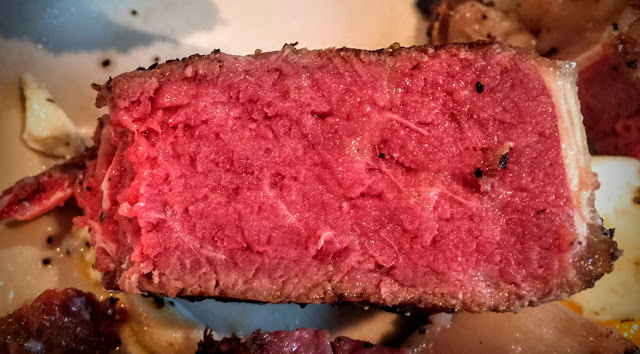My first experiment involved Sous-Vide VS Reverse Sear with some additional stuff on Salt and moisture loss. Comparing the results from the above experiment and this one could pose interesting.
I belong to several Facebook groups that discuss Sous-Vide cooking and on occasion the conversation turns to experimentation with salt. The argument goes like this...Should we SV with no salt?, Should we salt right before we SV, is there a benefit to dry-brining or not? Although the first experiment covered some of these issues it was necessary to do another one. As always I thought it would be fun to run another experiment but focus primarily on salt, flavor and moisture loss. Of course flavor is subjective but hard data will provide some insight. What role does salt play when it comes to meat? We're about to find out.
Before you read further you need to understand how I conducted my experiment and what were some of my ideas and protocols.
- All Prime steaks came from Costco and were similar in size. All about 11/2 inches.
- I used Diamond Kosher Salt.
- I used exactly and I mean exactly 1% of salt by weight. I.E if the steak weighed 400 grams I used 4 grams of salt. I have a very precise gram scale so this was easy.
- I coated the steaks evenly. Every square inch was covered with the measured salt.
- Each steak was coated with salt at a precise time.
- I made 8 steaks {first experiment) and all had different dry brine times (or not) Steak number #1- Received Salt 40 hrs prior to SV, #2- 24 hrs, #3- 12 #4- 6 hrs #5- 2 hrs, #6- 1 hrs, #7- salted and placed in Vacuum bag and #8- was naked, no salt.
- Note- #8- received salt at 1% and pepper before sear.
- Second experiment- Steak #1 Received Salt 40 hrs prior to SV, #2 Salted and placed in Vacuum bag and #3- was naked, no salt.
- Note- #3- received salt at 1% and pepper before sear.
- No plastic wrap was used during the dry-brining. All naked on a try. Plastic wrap does not aid in the dry-brining and it may pull off some of the salt and rub.
- All steaks were cooked at the same time.
- All steaks were SV at 128 degrees right right after they were vacuum sealed.
- The first 8 steaks were in SV for 75 minutes and in the second experiment for 150 min.
- All steaks received a Cold shock.
- All steaks were padded with paper towel prior to being weighed after SV.
- All steaks received a little pepper before hitting the grill.
- All steaks were grilled at the same time. None of the steaks received a robust sear.
- All steaks were allowed to rest 2 minutes before being weighed after sear.
What is dry-brining? Read here
Results will be at the bottom following the gratuitous pictures.
Some interesting observations. Having done this many times now this is what I have learned. There are many variables to these experiments and if you change just one of them you will get different results. Fat content, size and thickness of steak, how long you sear the steak and at what temp..etc will yield a different outcome so take this experiment with a grain of salt...pun intended.
I want you to consider these numbers for a moment. Steak #8- which was SV naked at 128 degrees for 75 minutes lost 8.97% moisture and in the second experiment Steak #3 lost 10.53%. Why??? Steak #3 in experiment #2 was SV for 150 min instead of the 75 minutes. What can we take away from this little experiment? Dry-brining can reduce moisture loss but only under certain conditions.... time and temp variables need to be considered. As you increase the time in water bath more moisture will be lost. In addition if you increase the temp of the SV more moisture will be drawn out. In my opinion dry brining gives a flavor boost and increases the flavor of beef.
Moisture retention is not always indicative of a great steak. Sometimes less moisture and greater salt penetration will yield a better steak I.E Steak number one.
A couple more things about the percentage of salt used. In my opinion if you're going to dry-brine for more than 6 hours you should cut the salt down to about .50-.66%. The salt penetrates so well you need to use less. Of course this is my opinion and you may want to experiment yourself.
My pronouncement is to Dry-Brine for at least 6 hours. In the end it was about flavor and not moisture that produced the superior steak.














Thank you! My family loves my sous vide steaks but I feel like they could be a bit tastier. Really appreciate the time you took to do this! Blessed Passover!
ReplyDeletewould suggest you make note of RINSING the salt off the steaks prior to Sous Vide, IF that is what you did...
ReplyDeleteLooks like there's an error with the 24-hour steak #2. It started at 377g and finished at 347g. That's a 7% loss, not 12%
ReplyDeleteI really appreciate you sharing that. A sous vide machine has been the best purchase I've ever made, which cooks meat super juicy and tender.
ReplyDelete